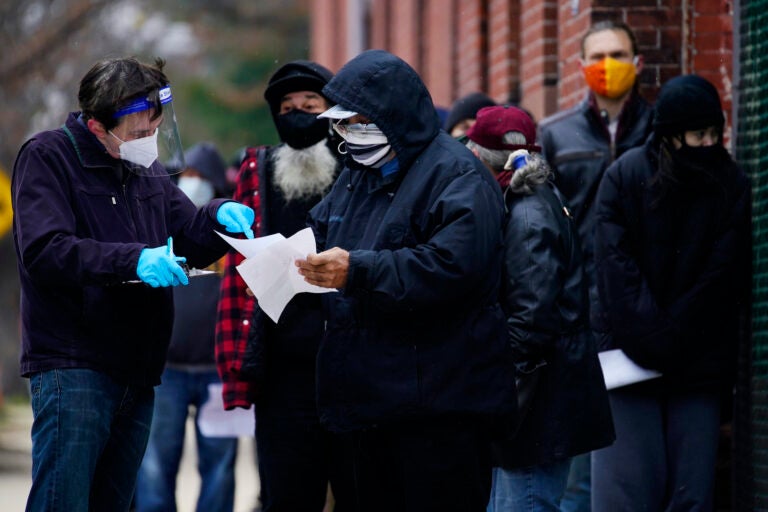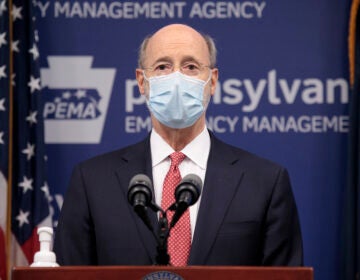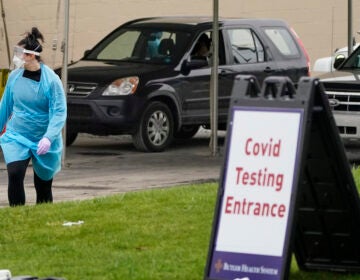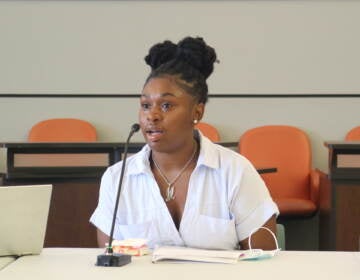What does ‘community spread’ of the coronavirus mean right now?
There are pleas for caution and newer, tighter restrictions on our activities — with possibly more on the way, even along with the coming vaccines.

People line up outside a community center to take a free COVID-19 test, Wednesday, Dec. 9, 2020, in Northeast Philadelphia. (AP Photo/Matt Slocum)
Ask us about COVID-19: What questions do you have about the current surge?
Jenine Ayres is confused.
As coronavirus cases rise throughout the region, she’s worried about the number of warnings officials are giving — and the number of people she doesn’t think are listening.
Ayres, who lives in Folcroft, Delaware County, said she doesn’t leave her house except to ride the bus to her job as a dental assistant. But she often feels alone in her caution.
“I think the governor should make us do what we did before in the spring. Because in the spring when we quarantined, I feel like the numbers went low,” she said. “Why haven’t they shut everything down like they did before?”
Right now, Philadelphia’s COVID-19 landing page lists the city at “high risk of community transmission.” Pennsylvania’s case numbers and hospitalizations, which have climbed steadily since October, don’t look much different. In Delaware and New Jersey, those rates and hospital intakes reflect or even surpass national averages. Infections associated with Thanksgiving have started to become apparent, as case numbers spike throughout the region.
But what does community spread really mean? And even with vaccines available very soon, what are officials and medical experts — and regular people, like Ayres — doing about it now?
Increased spread = increased risk
When public health experts talk about increased community spread, it’s just a way of saying that more people have been infected in an area, including people who don’t know how or where they were exposed to the virus. It also means that your chance of walking out the door and encountering someone with COVID-19, whether it’s a friend, a family member, or a complete stranger, is higher.
“In the summer, in some places, especially on the East Coast, our curve had been relatively flat, and that’s why we were able to open back up,” said Temple University epidemiologist Aimee Palumbo. “But now, in the fall, when we talk about community spread, that just means there’s that much more virus circulating in the community, and having those same gatherings are now higher risk than they were [before].”
It’s also meant tightened restrictions already in response to those shifting risks. Delaware has issued a new stay-at-home advisory and mandated mask-wearing. New Jersey has limited indoor dining hours and revised travel advisories. Pennsylvania, bracing for a hospital bed shortage, has expanded testing and contact tracing and broadened stay-at-home restrictions, with still more limits possible.
“I think people were scared more in the springtime than they are now,” Ayres said. She thinks another imposed quarantine would be good because it would force her neighbors to stay home. “I don’t think they all realize that they have other people’s lives in their hands.”
But public health officials and experts have said that complete lockdowns aren’t the answer, since states are in a better position than they were in the spring to respond to the virus and provide medical care. And epidemiologists like Palumbo say that the changing restrictions are a good sign. They reflect a response to the pandemic that’s informed and adaptable — that is, as long as the public listens and acts accordingly.
“We want to respond dynamically to the situation — because the alternatives are to let it go unabated, which is not desirable, or to put severe restrictions in place the whole time, and that’s also not desirable,” Palumbo said. “So this is not unexpected.”
There is limited information
Epidemiologists agree: In an ideal world, they’d know all the details about what was spreading the coronavirus, and where.
But in Philadelphia, for instance, data is primarily based on contact tracing efforts and self-reports from those who test positive. Not everyone who tests positive is reachable, which means information comes from a very small percentage of respondents, and, in turn, that public officials have inherently limited answers about where COVID is being spread.
“Due to the high number of new cases per day, we have not been able to contact the majority of new cases; we simply don’t have the staff,” city Health Department spokesman James Garrow wrote in an email to WHYY News. “For example, we completed over 2,000 interviews with COVID positive residents of Philadelphia in the month of November. This represents 11% of all cases; another 1% refused, 5% were attempted and unreached, while 82% were not attempted due to case burden.”
And even the people who can be reached don’t always know where they got infected. The week of Thanksgiving, Garrow said, approximately 42% of the cases contact tracers interviewed reported knowing they had an exposure to the virus. For those who knew how, 55% reported it was from someone in or visiting the household; another 14% reported exposure to someone at a social event; and another 10% said it could be multiple kinds of exposure (for example, friends and coworkers, social events and household). Hence, the department’s focus on infections from friends, family, and small social gatherings.
But while the city Health Department has no reason to believe the interviewed subgroup is any different than the larger population, it’s still a slim slice of data from which to extrapolate. City officials estimate that social activities especially remain under-reported.
“It’s also worth noting that some people tell us they did nothing and have no idea how they were exposed,” Garrow wrote, “and others probably under-report what they’re doing because they know they weren’t supposed to be doing it.”
Also, enforcement is limited
The government’s ability to enforce new restrictions is also limited.
“From a public health perspective, these policies make sense. There’s an evidence base for them, and we can say, ‘If [this] is enacted, and enforced, this will result in a downtick in cases,’” said Drexel University epidemiologist Neal Goldstein. “The problem is that it’s very difficult to enforce some of these things.”
Officials worry that when they close down bars, for example, people simply congregate elsewhere — in restaurants, where that is still possible, or in one another’s homes. That’s not a good idea.
“It’s still about people getting together, regardless of location,” Goldstein said. “If we have a cap on the number of people gathering at this business, it should be the same at your house.”
Frustrated? So are others
“At this point, I would like to know why we would keep shutting down businesses while others are flying, visiting, having weddings, stores have regular numbers of clients inside, etc.,” Delaware County resident Nancy Garthwaite asked WHYY.
Others are wondering, too.
Even Goldstein said he’d like to see more simplified, uniform messaging, since complicated restrictions have proven confusing or frustrating.
“It’s not that coronavirus prefers one location over another location,” he said. “It’s just that, the way that these rules have been rolling out, they focus on single entities where we’ve seen a lot of transmission happening … [but] the message has to be that we’re not trying to single anybody out here.”
The good news: This won’t last forever. Because vaccine trials have been promising, health officials say distribution could start as early as next week pending Food and Drug Administration approval, though the rollout will take months.
Until then, Goldstein said, we’ll have to stick it out for a while longer.
“We’re heading into a season where we see a lot more respiratory diseases become readily transmissible … We have to maintain good hygienic practices, not go anywhere we don’t need to go, interact with as few people as possible,” he said. “We’ve heard this message all along, and we’re going to hear it for the next few months.”
In Delaware County, Ayres is planning to do just that.
“I watch the news all the time,” she added. “I just saw that Governor Wolf was on there, and he was announcing that we’re in trouble. I was like, yeah, no shit.”

Get daily updates from WHYY News!
WHYY is your source for fact-based, in-depth journalism and information. As a nonprofit organization, we rely on financial support from readers like you. Please give today.




![CoronavirusPandemic_1024x512[1]](https://whyy.org/wp-content/uploads/2020/03/CoronavirusPandemic_1024x5121-300x150.jpg)



